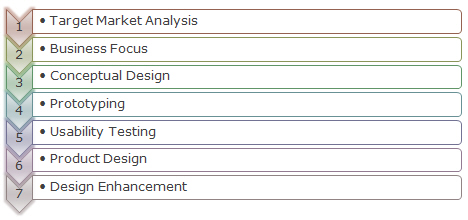The design of user interfaces is both a matter of design and engineering. RealConcept follows it own design methodology called RC-UID. It is based on the value and importance of the user-centric design process, understanding of the user-centric principles and process related to the target market. RC-UID is also about design methodology for bridging the user interface and technology.
We provide you with a wider perspective of ergonomics, or human factors, as practiced by engineers, psychologists and designers; filling in gaps in essential background knowledge that may be identified while building a user interface design.
RC-UID theory follows the 7 basic principles.

- Target Market Analysis: Identifying the users based on the product and user profiles.
- Business Focus: RC-UID believes in the "10 Seconds Focus Theory".
- Conceptual Design: Guide definition of user interface, functionality, navigation, interaction, architectural scheme and data flow. Navigational flow plays equally important role in the implementation of a good user interface.
- Prototyping: RealConcept provides an expertise in prototyping the web-based products / applications at any/all stages of developments. Prototyping models your final product and allows you to test attributes of the final product even if it's not ready yet.
- Usability Testing: Developing the task for the users to perform. Specifying the test environment. Assigning a real time experimenter. A real-time discussion with the users. Analyzing the user input data. Summarizing the usability test report.
- Product Design: Designing and application coding of the product and integrating it with database, existing application or 3rd party solutions.
- Design Enhancement: RealConcept methodology enhances the product interface based on the user feedback. It helps you prioritize the features and align the development process.
We provide an overview of the qualitative and quantitative methods employed in user interface research, stressing the need for the development of a theoretical framework of scientific rigor and consistency for the field of human factors, to make substantial progress. Our process & design principles are adapted by our clients to improve user experience.
- We characterize most of the methods, tools and techniques that are being used for the analysis, design and evaluation of user interfaces.
- We present the results of usability evaluations based on RC-UID technique.
- We solve user interface design or evaluation problem they may encounter in practice.
- We educate clients of classical methods such as GOMS*, RC-UID and cognitive complexity theory.
- We provide expertise in simulation of products, observation methods, event logging and processing.
- We perform heuristic evaluation and cognitive walkthroughs.
RC-UID also provides available research tools and techniques, to a certain extent, in order to learn their advantages and limitations, as well as to better appreciate the underlying research methodology.
*A GOMS model is composed of METHODS that are used to achieve specific GOALS. The METHODS are then composed of OPERATORS at the lowest level. The OPERATORS are specific steps that a user performs and are assigned a specific execution time. If a GOAL can be achieved by more than one METHOD, then SELECTION RULES are used to determine the proper METHOD. The GOMS model is a careful description of the knowledge needed to perform a given task and thus it describes the content of task-oriented documentation. You only need to tell the new user what the goals are, what different methods could be used to achieve them, and when to use each method (selection rules). This approach has been shown to be an efficient way to organize help systems, tutorials, and training programs as well as user documentation.


